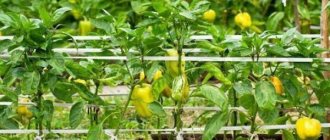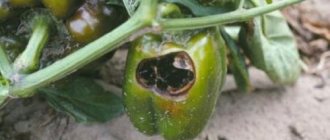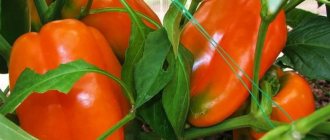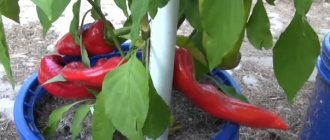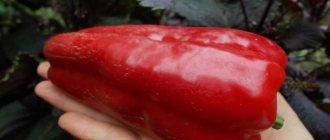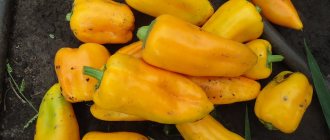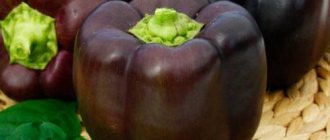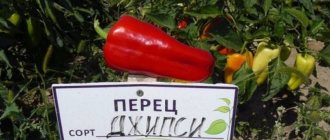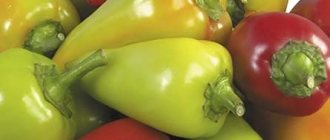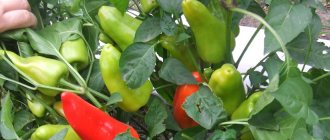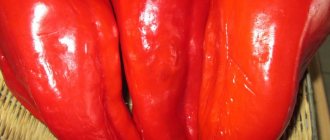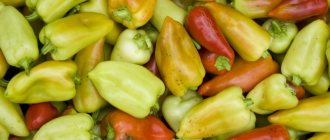For the third year now I have been planting the seeds of the sweet pepper 'Mammoth Tusks'. Peppers grow large, more than 20 cm in length. The taste is very sweet and juicy, especially the red color. The variety is very productive, there are more than 10 pieces on the bush.
Bouquet for September 1
I sow seeds for seedlings in early February. The shoots are always friendly; they need to be watered with warm water (about 30 degrees). To prevent the seedlings from reaching towards the window (towards the light), I install a frame with stretched foil on the other side of the box. It’s better not to delay the picking; I replant it in sour cream jars, which we collect during the winter. I spill the soil with a solution of potassium permanganate and place the transplanted sprouts in the shade for 2-3 days. I have a sunny side on my balcony, and therefore the seedlings are already blooming by May. I hang cardboard with foil glued to it on the wall, and the seedlings stand straight. Usually I planted it in the greenhouse already on May 1, but in the Moscow region there is a cold snap. So I'm waiting for the warmth. And I hope for a good harvest.
Yellow bell pepper
The 'Mammoth Tusk' pepper variety keeps well in the refrigerator until the New Year, and if it starts to lose its shape, I cut it and freeze it. In addition, very tasty salads are obtained for the winter with a very rich taste.
Description of pepper Mammoth Tusks F1, reviews, photos
An early-ripening, high-yielding, tall pepper hybrid with large fruits up to 27 cm long. Recommended for growing in greenhouses and open ground.
The bush is up to 1 meter high; it requires tying it to a support and shaping it. How to form mammoth tusk peppers, see the video below.
The hybrid is resistant to tobacco mosaic virus.
Fruit characteristics
The fruits weigh about 200 grams, with a wall thickness of 5-7 mm. The pulp is very tasty - tender, sweet, aromatic. The color of pepper in technical ripeness is green, in biological ripeness it is red. These peppers are good fresh; they are also suitable for all types of culinary processing.
A fabulous pepper, simply huge, its height was on par with a 10 liter bucket. Very sweet, tasty and juicy. Very productive. Grown through seedlings, then grew in a film greenhouse in Siberia, in the city of Nyagan Khanty-Mansi Autonomous Okrug
This is the second year I have been growing Mammoth Tusk pepper near Minsk. I’m very pleased, I’ll plant it again next year 2021. But I grow peppers in large pots, outside. I make a “pie” in a pot from good soil, fertilizer, dry manure, and mown grass. The peppers grow huge.
In the greenhouse the bush is up to a meter long, the fruits are up to 20 cm long, there are 20-25 pieces per bush, a late variety. I wanted to take the seeds, but it's a hybrid. I'll look in stores. This is Siberia
Mammoth Tusk F1 is a hybrid of sweet peppers with elongated, slightly curled fruits. The variety is characterized by a high degree of productivity. Find out more about the nuances of its description, properties, pros and cons, opinions and reviews of farmers.
Description and characteristics of the variety
Pepper Mammoth F1 occupies a place in the group of early ripening hybrids. He has early harvests - in 98-105 days. Plants reach a height of 50-60 cm, they have moderately branched and semi-spreading stems. There are a lot of fruits, they hang drooping from the clusters.
Breeders note the hybrid’s strong immunity, especially to TMV.
What are the distinctive features of fruits:
- average weight 200-300 g;
- length 20-25 cm;
- pericarp 3-4 mm;
- orange color (green first);
- the pulp is crispy, dense texture;
- The skin is glossy and durable.
As for the taste, the flesh of the fruit is sweet, but the septum is sharp. These peppers are good in fresh recipes, for preparations, or added to first and second courses.
Features of the plant: description of the hybrid and its fruits
Mammoth tusks F1 belongs to the early ripening hybrids of bell pepper. Seed producers call it productive and large-fruited. The variety has peculiar narrow curved fruits. Their color in a state of biological ripeness can be of two colors: yellow and red (see photo). Technically, it is equally green. Varietal planting material today is produced by TM Sibirsky Sad, Russian Garden and smaller companies. They allow the crop to be grown throughout the Russian Federation, in protected or open ground.
Attention! There is no pepper with this name in the State Breeding Register. But there is a Tusk variety from TM SibSad that is partially similar in description.
16 excellent varieties of plums for the Moscow region
The pepper bush is a tall plant. Individual fruits can reach 300 g, but are usually smaller. The thickness of the pericarp of pepper is 5-7 mm. The pulp is characterized as fleshy, aromatic, sweet and delicate in taste.
| Type of growth, bush height | Standard. Up to 1 m |
| Ripe fruit color | Red or yellow |
| Planting scheme | 50x80 cm |
| Weight, length and shape of the fruit | About 200 g, up to 27 cm, trunk-shaped, curved |
| Ripening period, yield | Early ripening (95-100 days). |
About 5-6 kg/m2 for any growing method
How and when to plant seedlings in a permanent place
Planting in open ground is a serious stress for plants, so it is necessary to adhere to planting dates, choose a suitable location on the site, and adhere to the pattern and depth of constant planting.
Deadlines
In the middle zone, seedlings are planted in greenhouse soil in early May, and planted in open ground in the middle or end of May, depending on the stability of the weather. At this time, the age of the plants has already reached approximately 70 days, from 8 to 12 leaves are formed on them.
At the time of planting, the upper layers of the soil should be warmed to at least +15°C, and the lower layers - to +12°C. The possibility of morning frosts is not allowed, as they significantly damage young shoots; daytime air temperatures should be kept within +18°C and above.
Choosing a location on the site
To ensure that the seedlings are comfortable and well-rooted, take into account the predecessor plants that grew in the selected area. Crops such as tomatoes, eggplants, potatoes, and physalis deplete the soil of the micro- and macroelements necessary for pepper.
It is also not allowed to replant sweet peppers in the same area where they grew last year. After planting and harvesting cruciferous crops, at least two planting shifts must pass for productive replanting of sweet peppers.
The following can be used as precursors that enrich the soil for pepper with useful microelements:
- basil;
- marjoram;
- onion;
- zucchini;
- cucumbers;
- pumpkin;
- early white cabbage.
As for the proximity to crops, it is not recommended to plant hot peppers, eggplants, potatoes, fennel and beets in neighboring areas, as they suffer from similar diseases and are affected by the same pests. A good “neighborhood” is considered to be planting next to carrots, marjoram, dill, onions and basil.
Advantages and disadvantages: opinion of experts and farmers
The structure of the fruit allows Mammoth Tusk pepper to be an excellent ingredient for fresh summer salads. Heat treatment will also not harm the taste and aroma. Pepper is good in various dishes and preserved. But it is not convenient to use it in all roles due to the peculiarities of the form.
List of other advantages:
- Availability of choice of growing methods: greenhouse or open garden bed.
- Large size peppers. Their high commercial quality, bright color.
- Immune resistance to certain diseases.
- Low demands on soil composition.
- Increased productivity. Breeders promise up to 12 peppers from one bush.
- Early ripening. If the subtleties of agricultural technology are observed, gardeners receive their first harvest by the end of June.
- The crop bears fruit until September inclusive.
How to care outdoors
After planting the seedlings in open soil, the most difficult stage of caring for pepper shoots begins. It is necessary to monitor their watering, fertilize, tie up and maintain high soil quality.
Watering
Pepper does not tolerate drought and reacts negatively to it, so it is recommended to water the plant twice a day - morning and evening. You cannot water peppers during the day, as moisture will act as a magnifying glass, sunburn will appear on the foliage and fruits, and the soil will dry out and crack. Practice root watering, and before moistening the soil, be sure to loosen it.
Soil care
The soil under the sweet pepper bushes must be loosened regularly to facilitate the flow of air to the roots of the plants, and accordingly, accelerate the formation of fruits and promptly destroy weeds.
During the first two weeks after planting, it is not recommended to care for the soil, since during this period the root system is strengthened, and damage to it can lead to a decrease in yield. Carry out weeding at the same time as loosening; do the first loosening to a depth of no more than 10 cm. If a dried crust has formed on the surface, the depth can be increased to 15 cm.
To warm and ventilate the soil, loosen the soil after each watering and heavy rain. To do this, choose a period in which the moisture has already gone, but the earth has not yet dried out. Mulching helps maintain the required level of soil moisture, prevents the emergence of weeds and protects the root system from drying out.
Use grass cuttings, straw, sawdust or compost for mulching - these materials suppress the development of plant diseases, contain beneficial bacteria, and can be spread in a layer about 6 cm thick.
Fertilizer application
Some of the best organic fertilizers for peppers are chicken droppings and manure. To prepare a solution for irrigation, mix 1 kg of manure or 0.5 kg of droppings with 10 liters of water and leave it to infuse for 5-6 days.
Mineral supplements such as:
- ammonium nitrate - 1 tbsp. l. for 10 liters of water;
- superphosphate - 2 tbsp. l. for 10 liters of water;
- potassium sulfate - 1.5 tbsp. l. for 10 liters of water.
The resulting solution must be diluted in 10 liters of clean water, and the plants should be watered with this mixture.
The first feeding of seedlings is carried out 12–14 days after planting them in open ground, then this procedure is repeated every 3–4 days. Remember that fertilizers must be alternated so that plants receive the full range of nutrients. Nitrogen compounds are effective in the formation of inflorescences by the plant, while phosphorus compounds stimulate the development of ovaries.
If you are unable to feed your plants at the recommended frequency, stick to the following watering schedule. Apply organic fertilizers two weeks after planting the peppers, and after another two weeks, fertilize them with nitrogen compounds.
Features of agricultural technology
Sowing seedlings should be done 65-70 days before. before transplanting the crop to a permanent place. Planting depth is 1 cm. Use growth stimulants. They will accelerate the emergence and development of plants, and also improve fruit set. For 1 sq. m of beds, plant no more than 2 bushes.
Sowing seeds for seedlings
Planting seedlings in a greenhouse/greenhouse
Planting seedlings in exhaust gas
Stepsoning
Harvesting (in the greenhouse / in the greenhouse)
| Drop off point | exhaust gas/greenhouse/greenhouse | |||
| Diseases | Resistant to TMV | |||
| By type of use | Universal | |||
| Flowering type | Female | |||
| February March | From the second ten days of May | The beginning of June | After 4 sheets | End of June/July |
| Reviews of the early ripening variety Summer resident Laura 39 (Kaliningrad) shared her personal experience of planting pepper Mammoth Tusk F1. She did not produce large fruits. The woman sees the reason for this in the shaded greenhouse. She collected the seeds and obtained from them a pepper with the same characteristics. Flower bed design. TOP 10 simple and effective techniquesFarmer fant1967 spoke about the practice of growing peppers in a greenhouse along with tomatoes. The harvest corresponded to the declared characteristics. The culture has good data, although it is not included in the State Register. The quality of peppers depends on compliance with agricultural practices. |
How to grow seedlings yourself
To get a good harvest, you will have to try and grow healthy seedlings. Choose seeds for sowing carefully and buy them only from trusted producers in order to get plants with the expected yield.
Deadlines
If you do not have a greenhouse, then you will need to start planting seeds for seedlings in February - this way you can get sprouts of the desired strength and height for transplanting them into open ground. Focus on the period from February 20 to March 5 and remember that seedlings need to be planted at the age of 60–70 days.
Soil and container
You can use a ready-made mixture for sowing Tusk, or prepare it yourself. The soil mixture recipe consists of 2 parts humus or compost, 1 part wet clean river sand and 2 parts peat.
Instead of peat, it is also possible to use leaf soil - its high looseness improves the structure of the soil, allows moisture and oxygen to saturate the entire root system and not stagnate in the upper layers. In order for all the components to mix well, they must be poured onto plastic wrap and loosened by hand.
Try not to use fertilizing and fertilizers at the initial stage, since peppers form a root system for a long time, and in the first one and a half to two weeks of life, the nutrients contained in the cotyledons will be sufficient for them.
It is also recommended to add sand to the store-bought soil mixture at the rate of 1 part sand to 6 parts soil. This will improve the soil structure and stimulate uniform distribution of moisture in the soil mass.
To disinfect a prepared or purchased mixture, use one of the methods below:
- Disinfection. Place the soil mixture in a plastic container with holes made in it, prepare a disinfectant solution from 10 liters of clean water and 3 g of potassium permanganate. Then water the soil and leave the container in a warm place for a day.
- Calcination. Pour the soil into fabric bags or a heat-resistant container, place the soil in an oven preheated to 200 degrees and let it sit for half an hour. Please note that this method destroys not only pathogenic organisms, but also beneficial substances, so the soil will need additional treatment with a nutrient solution.
- Freezing. Suitable for soil mixtures that were prepared in small volumes or in late autumn. Place the container or bags of soil in the freezer of the refrigerator for one and a half to two weeks, or take it out onto the balcony for all winter months. This will allow the soil to be cleared of pathogenic microflora and foreign seeds and prepare for planting seedlings.
Pepper seedlings do not tolerate picking well, since their root system is especially weak in the early period of life, so the optimal solution would be to plant them in individual peat pots.
When planting in seedling boxes, there will be a need to pick the plants, and not all even experienced gardeners can carry out this procedure without damaging the stems and root system of the plants.
There is another way to sow seeds for seedlings - peat tablets. Using peat tablets is considered the easiest way to grow a sweet pepper crop - just wet the tablets to make them swell and place the seeds in the holes made in the top of the tablets.
Seed selection and preparation
To choose high-quality store-bought seeds, check the production date and shelf life on the packaging. Please note that the optimal germination of pepper seeds is observed in the first year after they are collected.
Trust only trusted manufacturers of seed material, pay attention to the quality of the packaging - it must be well glued, printed and be sure to provide information about the company that produced these products.
Pre-germination of seeds is not difficult - spread the seeds in an even layer on a moistened canvas cloth and cover with the same cloth on top. Place them in a warm, dark place for a week, moistening the fabric of their spray bottle from time to time. Don't miss the moment when the seeds hatch, because the rudiments of the root system of peppers are very fragile and can be easily damaged when sowing.
